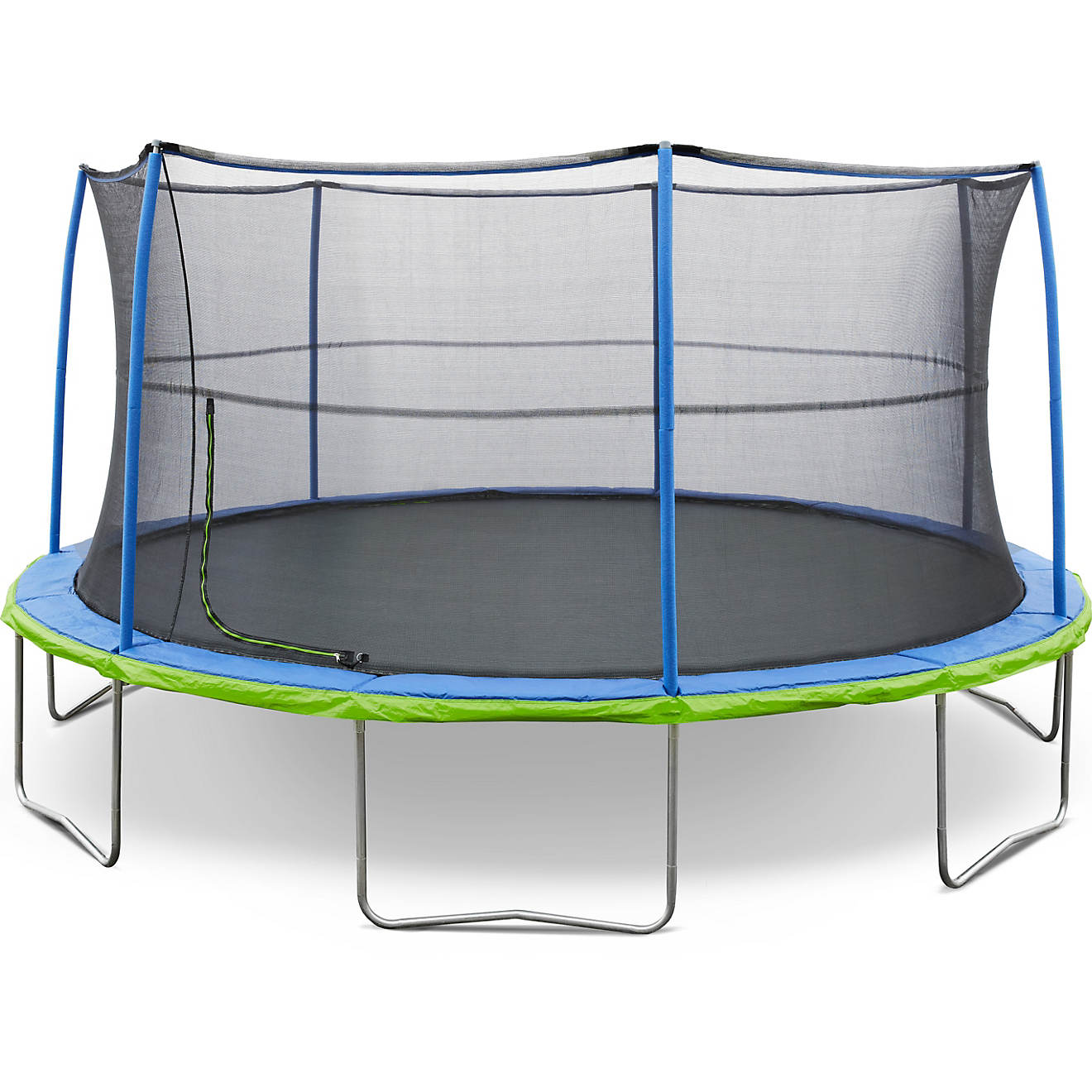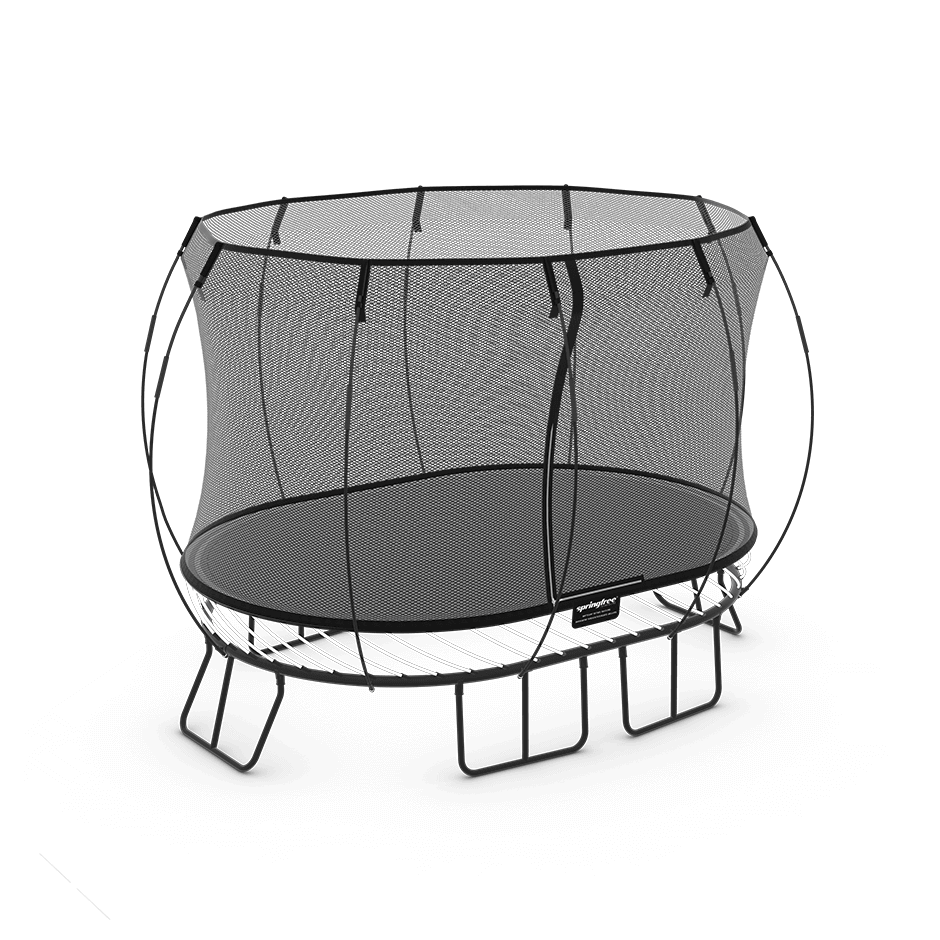How Much Does a Trampoline Cost? (2025)
Discover the true cost of owning a trampoline with this detailed guide. We provide real price ranges and throrough explanations to help you find your best fit!
min read

Trampolines can serve as a fun energy burner for children, an exercise platform for adults and a boost of joy for all.
But since you’re here, you must be wondering: “How much does a trampoline cost?”
At Springfree Trampoline, we get asked a lot about cost.
We pioneered the world’s safest trampoline, and our products tend to cost more than traditional trampolines.
With that being the case, we keep a close eye on pricing in the trampoline industry and will share that knowledge to help you prepare your budget.
In this article, we will examine the key factors that influence the total cost of a trampoline, as well as provide general price ranges to help you start planning.
4 Factors that Go Into the Cost of a Trampoline
Here are the four main factors that influence how much a trampoline will cost:
-
Type of Trampoline
The number one factor that affects the cost of a trampoline is the type of trampoline you’re talking about.
Here are some of the different types of trampolines with typical price ranges:
-
Above ground traditional, spring-based trampolines: $200-$3,000+
-
Above ground springless trampolines - $800-$4,000+
-
Inground Trampolines - $1,000-$5,000+
-
Mini trampolines (rebounders): $30-$500+
-
Water trampolines: $300-$3,000+
Since our expertise lies in backyard trampolines, we’re not going to go into detail about mini trampolines, indoor trampolines or water trampolines.
However, we made sure to put price ranges in the list above for those who are considering purchasing one of those types of trampolines.
While we provided the price ranges for all the trampolines above, let’s dive deeper into the subject by comparing traditional vs. springless trampoline costs.
Traditional Spring-Based Trampoline Cost vs. Springless Trampoline Cost
In the price ranges listed above, why were springless trampolines more expensive than traditional trampolines?
The answer: Springless trampolines have proven, via independent testing, to be the safest and highest quality type of outdoor trampoline.
There are many reasons for this, but the main ones include:
-
Most springless trampolines use flexible composite rods instead of springs, which can trap feet or toes.
-
The composite rods are made from material that is stronger than steel but more flexible, which helps eliminate a common cause of trampoline injury—falling injuries.
-
Springless trampolines have a longer life span because the rods are more resistant to rust and general wear-and-tear than metal springs.
-
Springless trampolines also tend to be more comfortable and less jarring to jump on than traditional trampolines.
Composite rods instead of springs are the reason springless trampolines are more expensive. Springs are typically not expensive.
For all of these reasons, you should expect to pay more for a springless trampoline.
Most of the time, the cost of a trampoline is the deciding factor for why somebody would choose a spring-based trampoline over a springless trampoline.
As a general rule: If you go with the traditional, spring-based trampoline, you will save some money but increase the chance of injury/shorter product lifespan.
If you choose the springless trampoline, you will get the safest and highest quality trampoline, but will be paying more for it.
Springfree’s Advice: Set your goals and establish your budget for a trampoline before purchasing. These factors will guide you to your ideal outdoor trampoline.
A traditional, spring-based trampoline (photo courtesy of Academy):

A springless trampoline (Springfree):

Above Ground Trampolines vs. Inground Trampolines
Another key factor that affects trampoline prices is how you want to install the trampoline: Either in the ground or above the ground.
Because inground trampolines are being installed in the ground, it requires a larger investment in money, time and space.
See the picture for an example of an inground trampoline installation (via Trampoline Holes):

The cost of an inground trampoline can range from $1,000-$5,000 or more, while an above-ground trampoline can range from $200-$4,000 or more, depending on the type and quality of the trampoline.
In addition to cost, choosing whether you want your trampoline to be installed in the ground or above the ground can affect the aesthetics, safety, durability, flexibility and accessibility of the trampoline.
Translation: It’s a very important decision to make.
Most trampoline owners have their trampoline installed above ground because it’s easier and more affordable, but inground trampoline do come with benefits (more aesthetically pleasing, eliminates falling risk, more accessible).
-
Quality of Materials
Another factor that can affect how much a trampoline costs is the material from which it’s made.
While most trampoline mats are made from the same black modulus polypropylene material, some will differ in what they use for the other elements of a trampoline.
For example, a trampoline made with a stronger galvanized frame, springs or padding will cost more than a trampoline constructed with a weaker combination of materials.
There are two main components (though not the only ones) you need to look at when assessing the quality of materials:
- The system utilized to get the bounce (springs, composite rods, bands).
- The sturdiness and durability of the frame.
The quality of these materials plays a huge role in determining the overall safety of a trampoline.
-
Design of the Trampoline
The design of the trampoline is another factor that influences trampoline costs, and it goes beyond its aesthetic appeal.
Design also describes how the trampoline is built. For instance, one trampoline may have springs on the outside of the net while one might have them inside the net (much riskier). One trampoline might have four legs while another one has six.
Trampoline safety is still the most pressing concern among adults purchasing a trampoline for their children, according to an internal survey we conducted.
The more that safety is incorporated into the design, the more expensive the trampoline will be.
Safety features like a flexible enclosure system, springs located outside of the trampoline and weather-resistant components are important to look for when assessing the overall design of the trampoline.
-
Size of the Trampoline
The last major cost factor involves the size of the trampoline.
To see this in context, here are three options from our Springfree Trampolines that demonstrate how size influences the cost:
-
Compact Oval Trampoline (6 ft x 9 ft)- $999
-
Medium Oval Trampoline (8 ft x 11 ft)- $1,649
-
Large Oval Trampoline (8 ft x 13 ft)- $1,849
As you can see, the greater the size, the more expensive the trampoline will be.
When discussing size, however, it’s important to mention that if you have young children and you want them to grow with the trampoline, it’s recommended to buy a big trampoline first.
Why? Even if that extra space is not needed right now, it could be when your child starts growing—and it can save you money from buying a larger trampoline down the road!
Example of the Springfree Large Oval Trampoline in a backyard:

Trampoline size isn't just about the frame-to-frame dimensions. Jumping room is also important, as is the shape of the trampoline.
Trampoline springs take off roughly 2 ft of jumping room on spring trampolines -- so a 15 ft spring trampoline is actually a 13 ft trampoline in jumping room!
Square and rectangular-shaped trampolines also tend to be more expensive than round or oval trampolines due to the extra jumping space.
The Verdict on Trampoline Cost
Whew...That was a lot of information. Let’s quickly hit on the key points around trampoline pricing:
Key Takeaway #1: The cost of a trampoline varies and depends largely on the type of trampoline, the materials it’s made from, its safety features and size.
Key Takeaway #2: You can go to a local retailer like Walmart right now and buy a trampoline for around $300. Or you can browse around the different trampoline brands and find a trampoline that costs thousands of dollars.
Key Takeaway #3: Ultimately, how much you decide to pay for a trampoline will depend on your goals and what you desire.
Check out our blog on what to look for when buying a trampoline to see how to narrow down your goals to find the best trampoline for you.
We’ve only covered the cost of the trampoline itself so far.
While the trampoline will obviously be the most significant part of purchasing a trampoline, there are other cost factors you should consider when discussing the overall price of owning a trampoline.
3 Other Trampoline Cost Factors
Trampoline accessories, installation and maintenance can also play a role in how much you ultimately pay for your trampoline. Below is a breakdown of each:
-
How Much Do Trampoline Accessories Cost?
Trampoline accessories are a fun and sometimes necessary way to upgrade your trampoline.
Just like trampolines, accessories for a trampoline can vary in cost depending on the type of accessory you’re talking about. Let’s look at a few examples:
-
Trampoline Ladder-$20-$99+
-
Trampoline Anchor Kit- $20-$99+
-
Trampoline Cover- $20-$199+
-
Trampoline Basketball Hoop- $30-$249+
The quality of the accessory, meaning how strong and durable it is, plays a huge part in how it’s priced.
For example, our Springfree Basketball Hoop, the FlexrHoop, is $199 largely because it’s made from the same premium material as our trampolines, which means it’s safe, high quality and flexible.
However, as evidenced by the price ranges, you can also buy a basic trampoline basketball hoop at Walmart for around $30.
For accessories, it’s going to depend on the trampoline you have/or are buying. Most trampoline accessories are brand-exclusive, meaning they are built specifically for one brand.
For instance, a Vuly Basketball Set would not work on a Springfree Trampoline (and vice versa).
If accessories are a must-have addition for you, make sure to look at each brand’s accessory offerings, as each brand will be a little unique in what they offer.
It’s usually best if you buy both the trampoline and accessories at the same time, since it will be easier to assemble all at once. However, you can always add accessories after your trampoline purchase as needed.
Example of a trampoline basketball hoop:

-
How Much Does Trampoline Assembly Cost?
Another thing you may need to concern yourself with regarding cost is the assembly of your trampoline.
Installing a trampoline can be time-consuming for some, which is why professional trampoline assembly is an option for some (although not all brands offer professional installation).
But, unless professional installation is included with your purchase, it will be an additional cost on top of the trampoline purchase.
For example, our Springfree Trampoline installation costs $399. A range of around $100-$500 could be expected for typical trampoline installations.
Installation could cost more, though, depending on your location, the complexity of the installation and who carries it out.
-
How Much Does Trampoline Maintenance Cost?
Maintenance for your trampoline is the final cost consideration we will discuss today, and this is usually a minimal investment.
Cleaning your trampoline is the easiest form of maintenance and can help prevent mat deterioration and rust on the frame or springs. Soap and water are usually the only requirements for a basic trampoline cleaning.
However, if your trampoline needs repairs or replacement parts, like a new net or mat, then you could start to see the price get into the $100+ range.
Before you order the replacement parts, though, check to see if your product is fully warranted and for how long (1-10 years is a typical range). If it is, the warranty can cut down on your long-term maintenance costs.
If you periodically clean your trampoline (once a month) and follow your trampoline manufacturer’s guidelines, maintenance costs shouldn’t be a huge issue for you.
Tip: Check the trampoline warranty length to get a gauge of when you might need replacement parts. It's typically an indicator of a manufacturer's confidence in the product.
Which Trampoline Is Best for You?
The cost of a trampoline is multifaceted, and it mainly comes down to what you desire in a trampoline.
If you’re just looking for the cheapest trampoline to save some money, then you can find $200-$300 trampolines at most major retailers that sell trampolines. However, the cheaper the product, the greater the chance of injury/product breakdown.
If you want the safer and longer-lasting trampolines, you can expect to pay in the high hundreds or thousands, depending on the factors discussed earlier. The better the product, the more expensive it’s going to be.
Now that you have a complete understanding of the total cost of owning a trampoline, would a trampoline be a worthwhile purchase for you? If so, which trampoline would be perfect for your backyard?
Check out our Trampoline Buying Guide, where you will find all the keys to a successful trampoline purchase!

